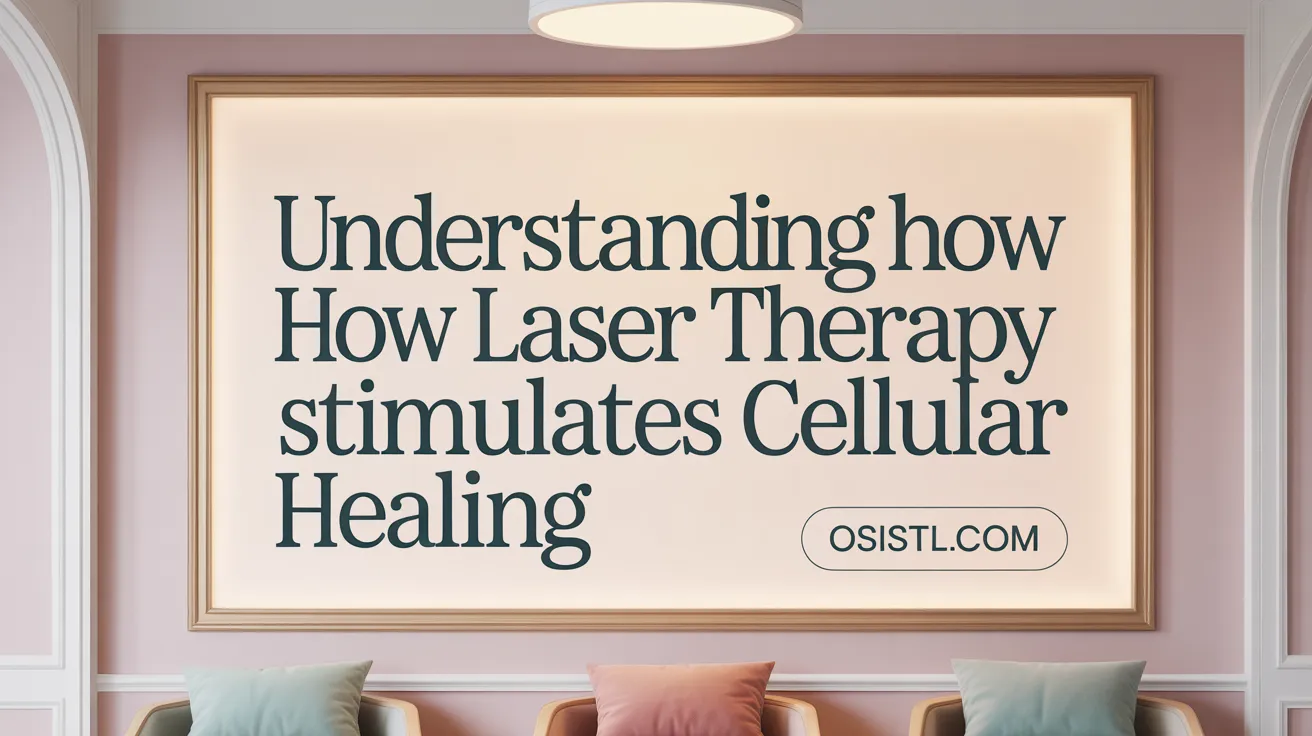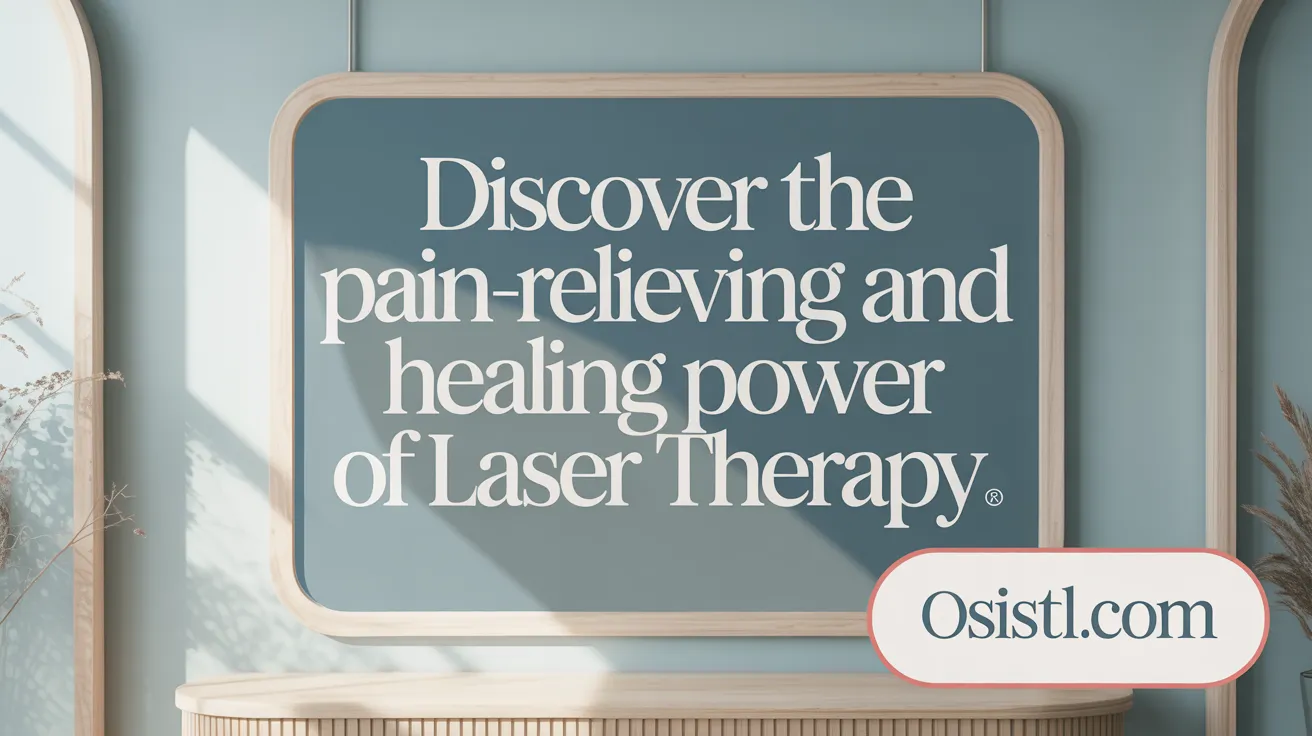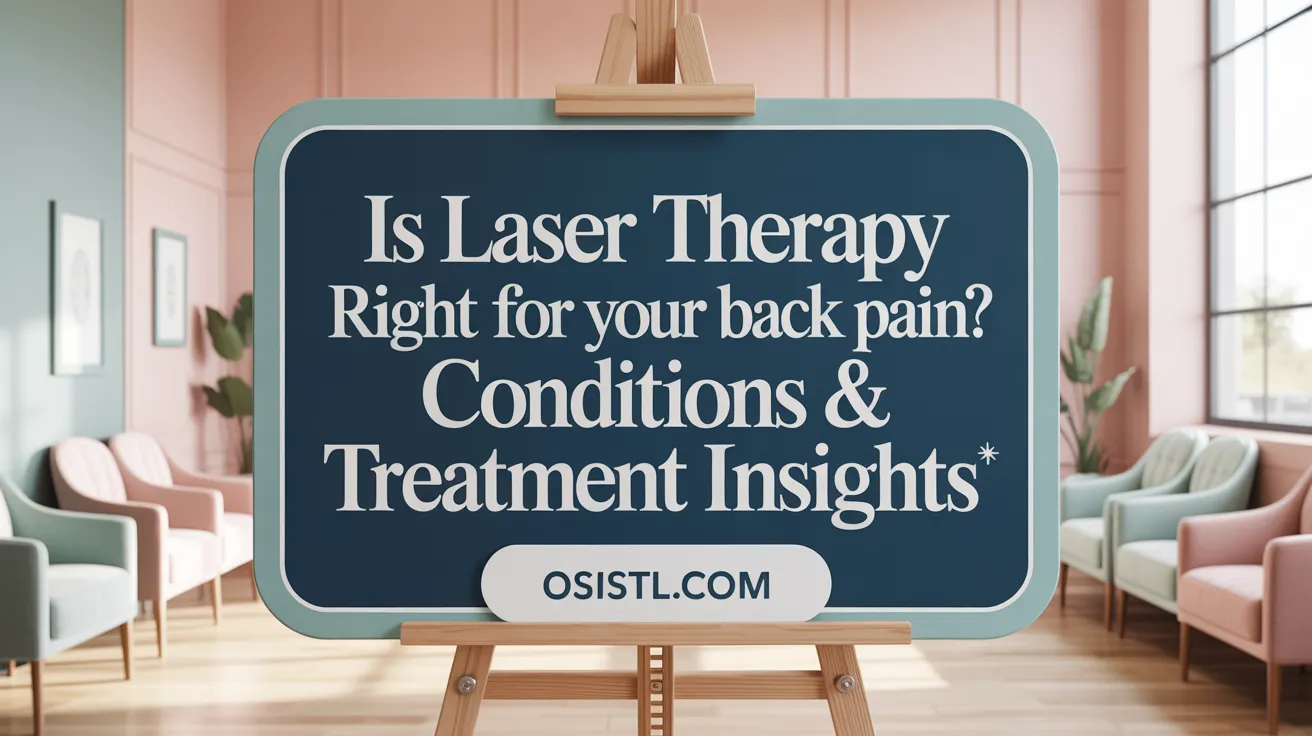Understanding Laser Therapy in Back Pain Management
Back pain is a prevalent condition impacting millions worldwide, prompting the search for effective, non-invasive treatments. Laser therapy, including low-level laser therapy (LLLT) and high-intensity Class 4 laser therapy, has garnered attention for its potential to alleviate pain, reduce inflammation, and promote tissue healing. This article explores how laser therapy works for back pain, detailing its physiological and biochemical mechanisms, treatment procedures, benefits, safety considerations, and evidence supporting its effectiveness.
Physiological and Biochemical Mechanisms Behind Laser Therapy
 Laser therapy, especially low-level laser therapy (LLLT) or photobiomodulation (PBM), relieves back pain by engaging cellular and molecular processes deep within tissues. At the core of its mechanism is the absorption of light energy by mitochondrial chromophores such as cytochrome c oxidase. This process boosts mitochondrial respiration and increases the production of adenosine triphosphate (ATP), the energy currency of cells, thereby enhancing cellular function and repair.
Laser therapy, especially low-level laser therapy (LLLT) or photobiomodulation (PBM), relieves back pain by engaging cellular and molecular processes deep within tissues. At the core of its mechanism is the absorption of light energy by mitochondrial chromophores such as cytochrome c oxidase. This process boosts mitochondrial respiration and increases the production of adenosine triphosphate (ATP), the energy currency of cells, thereby enhancing cellular function and repair.
The therapy also triggers the release of nitric oxide, a molecule that plays a significant role in reducing inflammation and improving blood flow. This combined increase in cellular energy and circulation accelerates tissue healing and diminishes inflammatory responses, easing pain.
Moreover, laser irradiation influences gene expression by stimulating reactive oxygen species (ROS). These molecules activate transcription factors that promote cell proliferation, fibroblast activity—which is crucial for tissue repair—and the formation of new blood vessels (angiogenesis). These biological activities underpin tissue regeneration, helping repair damaged tendons, cartilage, and other tissues involved in back pain.
Additionally, laser therapy modulates neural activity by decreasing the transmission of pain signals. It induces the release of endorphins and enkephalins, natural pain-relieving substances, and affects chemical mediators such as serotonin and bradykinins, which are involved in pain perception.
Through these combined biochemical and physiological effects—cellular energy boost, inflammation control, gene activation, and neural modulation—laser therapy promotes rapid tissue healing and pain relief. These mechanisms make it a promising modality for managing back pain and other musculoskeletal conditions, with ongoing research continuing to clarify its full biological impact.
Types of Laser Treatments Used for Back Pain

What types of laser treatments are used for back pain, including low-level and Class 4 laser therapies?
Laser therapy for back pain encompasses a range of treatment modalities, primarily low-level laser therapy (LLLT) and high-intensity or Class 4 laser therapy.
Low-level laser therapy, often called cold laser therapy, uses low-power lasers typically emitting less than 500 milliwatts. This type stimulates cellular processes such as increasing ATP production, promoting tissue repair, reducing inflammation, and alleviating pain. LLLT is especially effective for superficial tissues and is widely used to treat conditions like chronic musculoskeletal pain, arthritis, and soft tissue injuries. A notable example is the Erchonia FX 635 system, which emits laser light at a wavelength of 635 nm. Clinical studies suggest that LLLT can significantly decrease pain levels, improve function, and have benefits lasting up to a year.
In contrast, Class 4 laser therapy involves higher-powered lasers—those exceeding 500 milliwatts—that can penetrate deeper into tissues. This allows treatment of more severe or persistent conditions, such as deep muscle injuries, nerve pain, or disc-related problems. Class 4 lasers operate at wavelengths often between 650 nm and 980 nm, tailored to target specific tissue depths and types. The increased power accelerates healing, reduces inflammation rapidly, and provides more immediate pain relief. Learn more about high-intensity laser therapy benefits and mechanisms.
Both types of laser therapy are safe when administered properly by trained professionals. They are noninvasive, painless, and typically involve sessions lasting just a few minutes. While LLLT is excellent for mild to moderate issues and superficial tissues, Class 4 laser therapy addresses more complex, chronic, or deep tissue conditions. Emerging evidence supports their advantageous roles as part of multimodal pain management strategies, offering alternatives to medications or invasive procedures. For comprehensive insights on laser therapy safety and clinical effectiveness and FDA-cleared laser systems, see these resources.
Benefits of Laser Therapy for Back Pain: Pain Relief, Healing, and Inflammation Reduction
 Laser therapy, especially low-level laser therapy (LLLT), has gained recognition for its positive impact on back pain management. It primarily promotes pain relief by stimulating the body’s natural production of endorphins, which are the body's own painkillers, thereby decreasing discomfort. This process occurs through photobiomodulation, where laser light interacts at the cellular level, increasing ATP (energy) production within mitochondria, leading to enhanced cell function.
Laser therapy, especially low-level laser therapy (LLLT), has gained recognition for its positive impact on back pain management. It primarily promotes pain relief by stimulating the body’s natural production of endorphins, which are the body's own painkillers, thereby decreasing discomfort. This process occurs through photobiomodulation, where laser light interacts at the cellular level, increasing ATP (energy) production within mitochondria, leading to enhanced cell function.
Beyond pain relief, laser therapy accelerates tissue healing and collagen formation. Collagen is essential for repairing damaged tissues such as muscles, tendons, and ligaments, fostering quicker recovery from injuries and degeneration. The therapy also improves local blood flow, which ensures that nutrients and oxygen reach affected areas efficiently, promoting repair and immune support (Laser therapy for back pain).
Inflammation and edema are common in back pain conditions. Laser therapy helps reduce these by modulating inflammatory mediators, decreasing swelling, and enhancing lymphatic drainage. As a result, patients often experience a significant reduction in swelling and associated pain (laser therapy and inflammation reduction).
Moreover, laser treatment can restore function and mobility by decreasing muscle tightness and stiffness, thereby improving range of motion. Many patients report improved flexibility and reduced disability after a series of sessions, making daily activities easier (Range of motion improvements with laser therapy).
In summary, laser therapy offers a comprehensive approach to managing back pain through pain alleviation, accelerated healing, and inflammation control. Its non-invasive nature, combined with a good safety profile, makes it an appealing option for many seeking effective pain relief and functional improvement (Safety of laser therapy). While more research is ongoing, current evidence supports its role as a valuable adjunct in back pain treatment protocols.
For those exploring this option, consulting with healthcare providers about the potential benefits and suitability for their specific condition is recommended (Consulting healthcare providers for laser therapy).
Laser Therapy Treatment Sessions: What Patients Should Expect
What can patients expect during laser therapy treatment sessions for back pain?
During laser therapy sessions for back pain, patients will undergo a noninvasive, gentle procedure where a specialized low-level laser device directs light onto specific areas of the back affected by pain or inflammation. This process, known as photobiomodulation, stimulates cellular activity and promotes healing.
Typically, patients will feel a soothing warmth or a mild tingling sensation during the treatment. Importantly, no pain or discomfort should be experienced at any point. The session duration usually ranges from 3 to 10 minutes, depending on the size and location of the targeted area.
The number of treatments varies based on the severity of the condition and individual response. Most treatment protocols include about 6 to 12 sessions, scheduled a couple of times per week over several weeks. Patients are encouraged to continue with their healthcare provider’s recommendations for optimal results.
After each session, most patients feel no immediate aftereffects and can resume normal activities right away. Many report a gradual reduction in pain and improved mobility as treatment progresses. The safety profile of laser therapy is excellent when administered by trained professionals, making it an appealing option for those looking for a targeted and comfortable approach to back pain management.
Safety Considerations and Potential Risks of Laser Therapy for Back Pain
Laser therapy for back pain is generally safe when performed by trained healthcare professionals adhering to established safety protocols. Most patients tolerate the treatment well, with few side effects. However, mild and temporary skin reactions can occur, such as redness, warmth, or slight irritation at the application site. These effects typically resolve quickly and are not considered serious (Safety of laser therapy, Safety of low-level laser treatment, Laser therapy safety and side effects).
There are several important contraindications to keep in mind. Laser therapy should be avoided over malignancies or tumors, as the effects on cancerous tissues are not fully understood (Laser therapy effects on abnormal cells, Contraindications for Laser Therapy Use). Pregnant women, especially when treating lower back or abdominal areas, should consult their healthcare provider beforehand because safety data is limited for pregnancy (Laser therapy and pregnancy considerations). People with photosensitive skin conditions or taking certain medications that increase photosensitivity should also seek medical advice prior to treatment (Precautions and laser therapy safety).
Proper administration of the therapy is crucial. Laser devices must be properly calibrated, and operators should follow specific protocols regarding laser wavelength, power settings, duration, and treatment area. Using the correct parameters reduces the risk of adverse effects and enhances treatment efficacy (Laser therapy treatment parameters, Laser protocols and safety measures).
Protective measures are vital to prevent accidental eye injury, which is a rare but serious hazard. Both patients and practitioners should wear appropriate eye protection during the procedure. Laser beams should never be aimed directly into the eyes, and all reflective surfaces in the treatment area should be controlled (Laser protective glasses and eye safety, Laser equipment safety).
Overall, laser therapy has an excellent safety profile when used correctly, with low incidences of complications. Nevertheless, individual health status and medical history should be carefully assessed prior to starting treatment. This assessment ensures that laser therapy is suitable and safe for each patient, making it a reliable option for pain management when implemented with caution and expertise (Safety of laser therapy, Consulting healthcare providers for laser therapy).
Scientific Evidence and Clinical Outcomes Supporting Laser Therapy
Numerous clinical trials and systematic reviews have examined the effectiveness of laser therapy for chronic back pain. Randomized controlled trials, such as a 2020 study involving over 50 participants, have shown that low-level laser therapy (LLLT) can significantly reduce pain scores—up to 72.4% of treated individuals experiencing meaningful relief compared to placebo. Systematic reviews, including a 2022 analysis, have aggregated data from multiple high-quality trials and found that both LLLT and high-intensity laser therapy (HILT) can improve pain severity and increase functional capacity, particularly in nonspecific chronic low back pain.
The primary benefits are rapid pain reduction, improved range of motion, and decreased disability. Evidence suggests these effects last for at least three months post-treatment, with some reports of benefits persisting up to 12 months. The mechanisms behind these improvements include anti-inflammatory effects, enhanced microcirculation, nerve regeneration, and promotion of cellular healing processes, as explained in how laser therapy promotes tissue healing and the physiological effects of laser therapy.
While the short-term results are promising, the long-term benefits beyond one year are less definitively established. Many studies point out the need for larger, well-designed, independent research to confirm the durability of laser therapy’s therapeutic effects and its cost-effectiveness. The existing evidence supports laser therapy as a valuable adjunct in managing chronic back pain, especially when combined with physical therapy and lifestyle modifications, as noted in clinical research on laser therapy.
Despite the positive findings, limitations such as small sample sizes, potential bias in manufacturer-sponsored studies, and variability in treatment protocols underscore the importance of further rigorous research. Nonetheless, laser therapy remains a safe, non-invasive option with minimal side effects, making it an appealing choice for patients seeking alternatives to medications or surgery. Current clinical guidelines increasingly recommend nonpharmacologic interventions, including laser therapy, for comprehensive pain management.
Application and Suitability of Laser Therapy for Various Back Pain Conditions

Can laser therapy effectively treat chronic and acute low back pain?
Laser therapy, especially Low-Level Laser Therapy (LLLT), is increasingly recognized as a promising noninvasive treatment for both chronic and acute low back pain. It works by stimulating cellular processes through photo biomodulation, thus promoting tissue healing, reducing inflammation, and relieving pain. Evidence from clinical studies indicates that many patients experience significant pain reduction, improved function, and increased mobility after laser treatments.
How does laser therapy address sciatica and herniated discs?
For nerve-related conditions such as sciatica or herniated discs, laser therapy can be particularly beneficial. The deep tissue penetration effect of higher-class lasers like Class IV laser therapy facilitates healing of damaged nerve tissues and reduces nerve inflammation. Patients often notice decreased nerve sensitivity and relief from radiating pain, making laser therapy a useful alternative or adjunct to more invasive procedures.
Is laser therapy suitable for degenerative disc disease and arthritis?
Degenerative disc disease and joint arthritis are common causes of chronic back pain. Laser therapy can help by decreasing inflammation, promoting circulation, and stimulating tissue repair in affected areas. Some studies suggest that laser treatment can reduce the severity of pain and improve joint function temporarily. However, multiple sessions are usually necessary for sustained benefits, and it is best used as part of a comprehensive management plan.
Can muscle strains and other soft tissue injuries benefit from laser therapy?
Muscle strains, ligament sprains, and soft tissue injuries are suitable candidates for laser treatment. The therapy's ability to enhance blood flow and neural regeneration accelerates healing and reduces pain. Patients report feeling warmth and relaxing sensations during sessions, and many experience rapid improvement, allowing for quicker return to normal activities as shown in clinical evidence.
How to incorporate laser therapy with other treatment modalities?
Laser therapy is most effective when integrated into a multimodal approach, combining physical therapy, lifestyle modifications, and exercise. It serves as a supportive treatment that alleviates pain to enable patients to participate more fully in active rehabilitation programs. Consultation with healthcare providers can determine the appropriate laser parameters and treatment schedule tailored to individual conditions (source).
| Condition | Laser Therapy Role | Additional Notes |
|---|---|---|
| Chronic low back pain | Significant short-term relief | Mostly used as part of a broader treatment plan (source) |
| Sciatica, herniated disc | Reduces nerve inflammation, promotes healing | Longer-term benefits may require multiple sessions (source) |
| Degenerative disc disease, arthritis | Decreases inflammation, improves mobility | Best in combination with physical therapy (source) |
| Muscle strains, soft tissue injuries | Accelerates tissue repair, reduces pain | Rapid symptom relief and quicker recovery (source) |
In conclusion, laser therapy presents a versatile option suitable for various back pain etiologies. Its ability to target damaged tissues safely and effectively, combined with its minimal side effects, makes it a valuable component of a comprehensive pain management strategy.
Comparisons with Other Back Pain Treatments and Cost Considerations
When evaluating treatment options for back pain, it's important to compare laser therapy with other approaches such as medication, physical therapy, and surgery.
Laser therapy, especially Low-Level Laser Therapy (LLLT), offers a non-pharmacologic, minimally invasive alternative that promotes tissue healing and reduces inflammation without side effects associated with drugs or surgery.
Compared to surgical interventions, laser treatments are less risky, typically painless, and involve shorter recovery periods. They can be an effective step before considering more invasive options, especially for chronic conditions (Laser therapy for chronic low back pain).
Cost considerations vary widely depending on the clinic, with sessions ranging from US$30 to US$200. The initial investment in equipment like the FDA-approved devices can be around US$40,000, but these costs are generally absorbed by clinics and not directly passed to patients.
Insurance coverage for laser therapy varies by region and provider, often requiring prior authorization or proof of efficacy. Patients should check with their health plans to understand coverage specifics (Cold laser therapy overview).
Accessibility in clinics is increasing, with many private practices offering laser treatments as part of multimodal pain management (Laser therapy and physical therapy). Overall, laser therapy could be a cost-effective, safe, and efficient addition to conventional back pain treatments, especially when considering long-term benefits and fewer side effects (Benefits of laser therapy for back pain).
Summary and Future Outlook on Laser Therapy for Back Pain
Laser therapy represents a scientifically supported, noninvasive treatment option for managing back pain by harnessing the body’s innate healing processes through photobiomodulation. Both low-level and Class 4 laser therapies provide measurable benefits, including pain relief, reduced inflammation, and enhanced tissue repair, with a strong safety profile when properly administered. While research confirms significant short-term effectiveness and promising functional improvements, further high-quality long-term studies are warranted to solidify its role in comprehensive back pain management. Given its advantages over invasive procedures and pharmaceuticals, along with improving accessibility, laser therapy is poised to become a valuable component in individualized pain care strategies for diverse back pain conditions.
